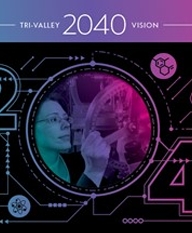From Livermore Vine | By Tim Hunt
May 19th, 2023
Come 2024 and 2025, the final plans for the Valley Link rail line should be set and construction should commence on the 42-mile rail line linking the Dublin-Pleasanton BART station with San Joaquin County cities.
The Innovation Tri-Valley Leadership Group threw a “lunch and learn” event at Shannon Community Center in Dublin to highlight its commitment to operating rail cars powered by hydrogen. As participants made clear, it’s the best choice and they expect the technology to continue to improve.
Currently, 105,000 people commute daily over the Altamont Pass and Interstate 580 is jammed as early as 4:30 in the morning until about 9:30 a.m. on weekdays.
Kevin Sheridan, head of Valley Link, pointed out that electrified trains running up the Interstate 580 median would involve major environmental and operational hurdles so that meant finding another fuel.
The current Union Pacific trains and the ACE trains operate with diesel engines, but the board did not want to go there, even using a more environmentally friendly diesel.
He also pointed out that the freeway is about as wide as is possible and commuter buses will be parked on the freeway right beside motorists.
That’s a key reason that the $1.86 billion rail link makes sense, plus it will provide much more frequent trains than ACE and have the BART connection to bring riders into the core Bay Area.
With hydrogen as the fuel choice, Valley Link is working with Stadler US, a division of the Swiss multi-national rail car company. It has already tested its hydrogen train for more than 1,000 miles in Europe and anticipates more than 2,000 miles when it enters service in San Bernadino County, said Kaden Kiillpack who manages that project in Southern California.
To supply the hydrogen, Linde North America is planning a manufacturing plant in Tracy that initially will supply 5 tons per day.
Valley Link is expected to use 3.5 tons so it will have capacity to fuel other trucks. Given the abundance of distribution centers in San Joaquin County and the state mandate to eliminate diesel-powered tractors, I suspect there will be no issue finding a market.
Wladimir Sarmiento-Darkin, business development director for Linde, said his company’s biggest challenge will be rapidly scaling up its manufacturing sites to meet demand that he expects to soar.
The same could be said for the electric vehicle charging stations as well as major improvements to PG&E’s old grid.
While on the subject of traffic on I-580, work is underway for the temporary fix for the eastbound lane that slid away in the heavy storms. That work is expected to be finished within two weeks and the design for the long term fix is underway with construction expected to start in two months.
One of the alternative commute routes, Tesla Road, has been closed since the torrential rains. John Medlock Jr. of Alameda County Public Works said workers were able to stabilize the road with 1-ton boulders and it should re-open next week.
Meanwhile, work on fixing the slides into Shadow Cliffs on Stanley Boulevard has started. The contractor is working 10-hour days, six days a week with a target of completing the cellular concrete bank by June 10.
Medlock pointed out that the county has 19 repair jobs coming from the atmospheric rivers that pounded Northern California, about three times more than occurred in the winter of 2017.
Editor’s note: “Tim Talk” is a blog written by Tim Hunt, a native of Alameda County. Hunt spent 39 years in the daily newspaper business and wrote a column for more than 25 years in addition to writing editorials for more than 15 years.
Originally posted https://www.livermorevine.com/opinion/tim-talk-valley-link-rail-will-be-powered-by-hydrogen-7028149



